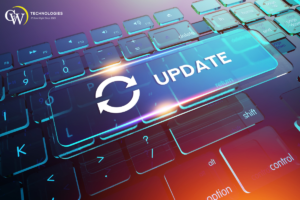IT Disaster Recovery Planning: The Smart CIO’s Guide to Protecting Your Business from the Unthinkable
Why Business Continuity and IT Disaster Recovery Planning is Essential for Small to Medium-Sized Businesses
Imagine a CIO driving their car without insurance. What would happen if they got into an accident? Without any coverage, they’d be on the hook for all damages—that’s a lot of money!
Now, imagine that same CIO not having a disaster recovery plan in place. When disaster strikes, not only will the organization have to pay out of pocket for whatever damage it incurred, but it may also lose valuable data and resources that could’ve been saved with an effective DRP.
Don’t Let Disasters Derail Your Business: How IT Disaster Recovery Planning Can Help
It’s a sad fact that hurricanes, floods, and other natural disasters can strike without warning. But it’s even more unfortunate when unprepared businesses are left scrambling to recover their lost data without the help of a robust Disaster Recovery Plan (DRP).
As any Smart CIO Knows, having a DRP in Place is like Having car Insurance: You Hope You Never Need it, but if Something Goes Wrong, it can Save Your Business from a Disaster Scenario.
A DRP helps ensure that your network is up and running quickly after disaster strikes – so you can get back to business as usual with minimal business disruptions.
Don’t take the risk of going without a DRP like going without car insurance. Instead, invest in one so you don’t end up paying more than necessary when a disaster scenario does strike.
Don’t be foolish – make sure your organization is protected. It’s the only way to make sure your data and resources are safe!
Be proactive. Don’t let yourself be caught off-guard when disaster does strike – put your trust in experts who can provide the best possible protection for your organization.
Neglecting to set up your disaster recovery plan is just like driving without car insurance. Make sure you have the right coverage so that when disaster does occur, you’re prepared with a plan of action and ready to go!
What is an IT Disaster Recovery Plan (DRP)?
Disaster recovery plans – or DRPs – are structured and documented ways to describe if an organization needs to quickly recover from unplanned incidents. DRPs are important components of the business continuity plan (BCP). This applies in particular to areas within organizations that depend upon IT management. DRPs are used to assist an organization with recovering system functionality after losing data and may also recover the system functionality after the event. This plan includes measures to minimize disaster impacts to ensure the business continues to operate as envisioned and immediately re-establish the mission-critical function it was previously.
What are the Five Major Elements of a Typical Disaster Recovery Plan?
Disaster recovery plans represent the response component in your company’s managed compliance solution. It covers procedures, technologies, and goals that enable swift recovery from disaster. The following are the five major elements of a typical disaster recovery plan:
- Risk Analysis: It all starts with a network assessment. The first step in creating a disaster recovery plan is to identify potential threats and assess their potential impact on the organization. What is your business impact analysis? This involves identifying critical business processes, data, and systems, and determining how long the business can afford for them to be unavailable.
- Backup and Recovery Procedures: Data loss can be detrimental and cause business interruption. A crucial element of any disaster recovery plan is having a robust backup and recovery system in place.
- Communication Plan: A DRP should include a clear communication plan that identifies key personnel, roles, and responsibilities during a crisis. It also outlines recovery time objectives.
- Continuity of Operations: Let’s ensure Business continuity. In the aftermath of a disaster, it’s essential to have a good disaster recovery plan and internal recovery strategies in place for continuing critical operations.
- Training and Testing: Finally, a disaster recovery plan is only as effective as the people who implement it. Disaster scenarios should be tested before disaster strikes to define the recovery process for your business.
More Blogs Here!

5 Breakthroughs in Technology and Climate Change

AI Security: Best Practices and Key Strategies

The Impact of AI: Transforming Industries and Everyday Life

Celebrating 40 Fantastic Years at C&W Technologies

Business Mission – Get to Know C&W Technologies

The Dream Team – C&W Technologies

Tariffs – What They Are and How They Affect Businesses

Phishing Alert! – Watch Out for Email Attacks

Voicify – The Ultimate AI Phone Answering Service

VOIP – The Smart Business Phone for Modern Businesses

Delete Files Safely and Prevent Data Loss

Windows 10 End of Life

Auto Updates – Keeping Software Refreshed and Up to Date

Cloud Solutions – A Game Changer in the Workplace

Tools for Team Collaboration with Microsoft

Webinar Alert! – AI Takes the Business World by Storm

What’s Happening in AI? New Trends and Statistics

Sustainable Data Centers – Reduce IT’s Carbon Footprint

Digital Privacy Enhancements – Beware of Data Breaches

Elon Musk’s Cybercab Robotaxi

The Future of Police Drones: What’s Next in 2025 and on?

Cyberattacks and the Importance of Prevention of Financial Damage

Building a Connected and Efficient Digital Workspace with M365

Budgeting for IT Needs and Investments in the New Year

Kickstart Your Business: Essential IT Resolutions 2025

The Impact of Gen Z on Technology Trends for the Future

5 Benefits of Multi Factor Authentication- A Necessity in Businesses

Patch Management – How to Protect Your Businesses Data
How Does Disaster Recovery Differ from a Simple Backup?
The term Backup describes creating copies of information and documents essential to business processes. The recovery process for disaster recovery can be more complex. Data losses frequently occur, whether due primarily to human error or unexpected events.
What are your data streams? Is your data in a data center? Many organizations keep their internal data copies on cloud storage with the help of cloud managed IT services. Disaster planning doesn’t just restore file systems but helps to restore the whole business’ IT systems including data and applications, to keep them functioning properly longer.
The right disaster recovery team can help organizations to develop and implement a DRP. A good disaster recovery plan should identify the data that is most important to an organization, consider how long it would take to recover from a disaster, and ensure the necessary resources are in place for recovery.
Does Your Incident Management Plan Maximize Uptime and Minimize Downtime? What is Your Recovery Time Objective?
Including a disaster recovery plan (DRP) in your overall IT strategy can significantly maximize uptime and minimize downtime for your business. The DRP is essentially a set of procedures that outlines how your organization will respond to unexpected events, such as natural disasters, cyber-attacks, or hardware failures.
One of the key benefits of a DRP is that it allows you to restore critical systems and data quickly. With a comprehensive data backup and recovery system in place, you can quickly recover lost or damaged data, and restore essential systems to their previous state.
Remember to Keep Your Business Operations in Check
Another benefit of defining a disaster recovery process and business continuity plan is that it ensures effective communication between teams during an emergency. This helps ensure that everyone involved in the recovery process understands their roles and responsibilities and that there is efficient communication between key personnel. This can help minimize downtime by ensuring that everyone is working together effectively to resolve the issue at hand.
Data Loss? Sensitive Data? Keep Your Information Systems Locked, Safe, and Secure! Get the Protection Your Business Needs
A Disaster Recovery Plan (DRP) is essential for protecting your business against unexpected events and disasters. It outlines the procedures for responding quickly and efficiently to crises. By having a DRP in place, organizations can minimize downtime by focusing on mission-critical functions and maximize uptime by providing the opportunity to resume operations as soon as possible and ensure their data is safe from harm. A good disaster recovery plan will address potential risks such as cyber-attacks or malicious software infections.
Let’s Talk Dollars and Cents
The cost of not having a DRP in place can include loss of data, customers, and revenue due to downtime caused by unexpected events like cyberattacks or natural disasters.
Additionally, the lack of a DRP could also lead to expensive fines resulting from regulatory violations or breach notifications.
C&W is the Business Continuity Expert for You
The continuity of your business is paramount. A business continuity plan is a detailed strategy that ensures the processes and systems within a business continue even if unplanned circumstances make this difficult. Don’t wait for disaster to strike – start protecting your organization today! Invest in managed IT services and a dependable disaster recovery plan now, and you won’t regret it. Get the coverage you need so that when disaster does occur, you’ll be prepared with a plan for success!
What’s the Bottom Line?
When disaster strikes, be prepared! Be a responsible CIO – take the time to get the right DRP and managed IT services in place before any damage occurs. You don’t want to end up like the foolish CIOs who didn’t have any car insurance—don’t make the same mistake with your Disaster Recovery Plan! Invest in protection now so that when disaster strikes, you’ll be ready.
What are your recovery objectives? How secure is your IT Infrastructure? Your organization’s data and resources are too valuable to risk leaving unprotected. Get the coverage you need now and make sure your DRP is in place before disaster strikes – it’s the only way to ensure your data remains safe and secure! Ensure the security of your entire system.
Are your system components set up for rapid recovery? Don’t wait for disaster to occur – get the right coverage today and protect yourself from a future of regret!
The bottom line: it’s foolish not to have a Disaster Recovery Plan. Invest in managed IT services and protection now, so when disaster strikes, you won’t be left with costly damages or lost data. Be a responsible CIO by getting the right coverage – don’t end up like those who drove without car insurance!
Expert Disaster Recovery Planning Services Tailored to Your Business Needs
Protect your organization today with managed IT solutions and a dependable Disaster Recovery Plan. Don’t let yourself be caught off-guard when disaster strikes – put your trust in experts who can provide the best protection for your data. Get started on planning now, and don’t be foolish like those who don’t have any car insurance!
At C&W Technologies, we understand that small to medium-sized businesses need a disaster recovery plan that is tailored to their unique needs and budget. That’s why we offer customized disaster recovery planning services to help our clients protect their businesses and minimize downtime in the event of a disaster.
What’s in Your Incident Response Team? C&W – Your Technology Business Partners
Let C&W Technologies become your business partner. Our team of business continuity experts will work closely with your business to understand your specific needs and risks and develop a comprehensive recovery point objective that meets your requirements. This plan will include all five major elements of a typical disaster recovery plan, as well as any additional considerations specific to your business.
We’ll help you assess potential risks, identify critical information technology systems and data, and develop backup and recovery procedures that will ensure your business can recover quickly from any disaster. We’ll also help you develop a communication plan that outlines how key personnel will be notified in the event of an emergency, and what steps they should take to respond.
Business Disruption Cause Havoc!
We will help outline technology recovery strategies to get your primary business site back up and running in the event of a disaster. Our continuity of operations plan will ensure that critical business functions can continue in the aftermath of a disaster, and our training and testing programs will help ensure that everyone involved in the recovery process understands their roles and responsibilities.
In addition to developing a disaster recovery plan, we’ll help you implement and test it to ensure that it works as intended. We’ll also provide ongoing support to help you maintain and update your plan as your business evolves.
Unexpected Events Can Happen Anytime – Is Your Business Ready?
What are your disaster recovery procedures? Are you prepared for a natural disaster event? At C&W Technologies, we are business continuity experts.
We understand that small to medium-sized businesses face a range of operational risks, from natural disasters, cyber-attacks hardware failure, and cloud services with a robust cloud disaster recovery plan, we’re committed to helping our clients prepare for the unexpected.
By working with C&W Technologies, you can have peace of mind knowing that your business is prepared when a disaster occurs. Our disaster recovery planning services are tailored to your specific needs and budget, so you can get the protection you need as a cost-effective solution. Contact us today to learn more about how we can help you safeguard your business.
Don’t Wait Until It’s Too Late
Don’t wait for a disaster – now is the time to invest in a Disaster Recovery Plan! Contact us at C&W Technologies today and get a customized plan tailored to your business’s needs. Visit our website and fill out the contact form to get started!
With C&W Technologies on your side, you can be sure that your business is prepared for anything.
Frequently Asked Questions (FAQs)
Q: Why is IT strategic planning important?
A: IT strategic planning ensures that your organization’s technology investments support its business goals. It helps avoid costly and time-consuming mistakes, increases efficiency, and provides a roadmap for future growth and change.
Q: How can an IT strategic plan manage risks?
A: By identifying potential IT risks such as cybersecurity threats or technology obsolescence, an IT strategic plan can help organizations develop strategies to mitigate these risks.
Q: What is meant by business objectives in the context of disaster recovery?
A: In the context of disaster recovery, business objectives refer to the goals a company sets to ensure continuity and recovery of operations in the event of a disaster. These typically include Recovery Time Objective (RTO) and Recovery Point Objective (RPO).
Q: Who should be involved in the IT strategic planning process for IT disaster recovery?
A: This process should involve key stakeholders including IT leaders, business continuity managers, top management, and potentially clients or regulatory bodies.
Q: What are some common challenges in developing a disaster recovery strategy?
A: Common challenges include understanding the full scope of potential risks, setting realistic recovery objectives, securing adequate resources for plan development and implementation, and maintaining staff training and awareness.
Q: How often should strategic planning be reviewed?
A: The strategic plan should be reviewed at least once a year. However, it can be reviewed more frequently depending on changes in the business environment.
Q: What are the key elements of a business strategy?
A: Key elements include the company’s vision and mission, strategic objectives, target market, competitive advantage, business model, and plans for operations, marketing, finance, and human resources.
Q: How long does it take to create a strategic plan?
A: The time it takes to create a strategic plan can vary widely from one organization to another. It might take a few weeks to several months, depending on the complexity of the business and the degree of consensus needed.
Q: How often should a Company’s strategic objectives be reviewed and updated?
A: Strategic objectives should be reviewed at least annually. However, depending on changes in the business environment or the company’s performance, more frequent reviews may be necessary.


